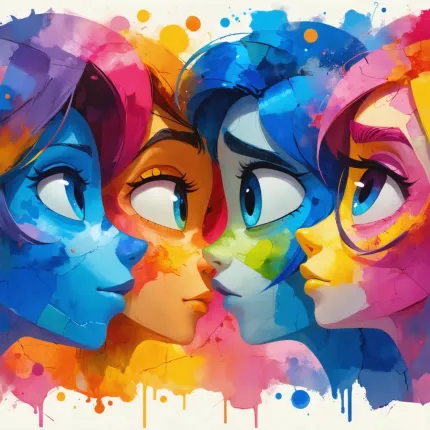
Have you ever felt that sudden flush creeping up your neck when you realize you've just said something awkward in front of a crowd? That familiar sting of embarrassment is one of those deeply human emotions that can feel both uncomfortable and oddly enlightening. Pixar’s original Inside Out brilliantly brought to life the vibrant world of emotions inside a young girl’s mind, capturing Joy, Sadness, Anger, Fear, and Disgust with vivid personalities. But as the sequel, Inside Out 2, hits screens, there’s a new emotional player stepping into the spotlight: embarrassment.
Why does embarrassment matter now? And how does it enrich the already colorful emotional palette the first film introduced? For fans of the franchise, parents curious about the psychological depth behind the storytelling, and anyone fascinated by emociones inside out, this development is more than just a narrative tweak—it’s a reflection of how complex and relatable our internal emotional worlds truly are.
The Emotional Landscape Evolves: Why Embarrassment Deserves a Seat at the Table
When the original Inside Out debuted, it was easy to see why the five core emotions were chosen. Each represented a fundamental aspect of our emotional life, serving as accessible archetypes for children and adults alike. However, as we grow, our emotional experiences become more layered and less straightforward. No longer is it just about feeling happy or sad; embarrassment, shame, pride, and other subtle feelings weave into our daily psyche, shaping our decisions and interactions.
Inside Out 2 embarrassment is a crucial addition because it captures that awkward, sometimes cringe-worthy sensation that everyone encounters but rarely discusses openly. It’s that feeling that reminds us we’re human, that we care about how others perceive us, and that our social connections are vital. This emotion isn’t just a fleeting nuisance; it’s a powerful signal that influences self-awareness, empathy, and growth.
Think about the last time you had an embarrassing moment—maybe a slip of the tongue during a presentation or an unintended faux pas at a family dinner. That experience likely triggered a cascade of responses inside your mind, involving more than just embarrassment alone. It was probably mixed with anxiety, a touch of sadness, or even anger at yourself. This interplay is precisely what Inside Out 2 seeks to portray, deepening the concept of emociones inside out to capture life’s emotional complexity.
From Flushing Faces to Emotional Depth: What Inside Out 2 Teaches Us About Embarrassment
So, what can audiences expect when embarrassment takes center stage in the sequel? For starters, the film doesn’t treat embarrassment as a simple “bad” feeling to be avoided. Instead, it explores how this emotion can lead to self-reflection and connection with others. By dramatizing embarrassment inside out 2 style, the narrative acknowledges the vulnerability that comes with being imperfect and the courage it takes to face social blunders head-on.
Inside Out 2 embarrassment offers a fresh lens on how we process moments that make us feel exposed or judged. The emotion’s presence in the film helps illustrate that these uncomfortable feelings are part of a healthy emotional ecosystem. They can teach us resilience, humility, and even humor—turning cringe-worthy moments into opportunities for growth.
- Understanding social cues: Embarrassment helps us gauge how our actions impact others, fostering empathy.
- Encouraging authenticity: By accepting embarrassing moments, we embrace our genuine selves.
- Building emotional intelligence: Recognizing and managing embarrassment strengthens our emotional toolkit.
Moreover, Inside Out 2’s inclusion of embarrassment broadens the conversation about emociones inside out, reminding us that emotions are not isolated islands but interconnected forces shaping who we are. This nuanced portrayal helps both younger viewers and adults grasp the importance of all feelings, even the uncomfortable ones.
In the following sections, we will delve deeper into how embarrassment is portrayed in the film, its psychological significance, and why this emotional addition marks a meaningful evolution in Pixar’s approach to storytelling. Whether you’re a parent, educator, or simply a fan of emotional narratives, understanding embarrassment inside out 2 style will enrich your appreciation of the film and the emotional worlds within us all.

Exploring the Role of Embarrassment in Inside Out 2
How Does Embarrassment Inside Out 2 Enhance the Emotional Narrative?
Embarrassment inside out 2 plays a crucial role in expanding the emotional complexity portrayed in the film. Unlike the first movie, which primarily focused on five core emotions—Joy, Sadness, Anger, Fear, and Disgust—Inside Out 2 introduces embarrassment as an additional layer of emotional experience. This addition reflects a more nuanced and realistic depiction of human feelings, acknowledging that embarrassment is a common, relatable, and significant emotion, especially during adolescence.
By incorporating embarrassment inside out 2, the filmmakers deepen the audience’s understanding of how emotions interact in complex social situations. It highlights the internal conflict children and adults face when trying to balance self-awareness and social acceptance. This helps viewers empathize with the characters’ struggles and growth, making the emotional journey more authentic and engaging.
Why Is Inside Out 2 Embarrassment Important for Emotional Development?
Inside Out 2 embarrassment doesn’t just serve as comic relief; it symbolizes an essential stage in emotional development. Embarrassment often arises from social feedback and self-consciousness, which are critical for developing social skills and self-regulation. By portraying embarrassment vividly, the film educates audiences about:
- Self-awareness: Recognizing one’s own social missteps or vulnerabilities.
- Empathy: Understanding how one's actions affect others emotionally.
- Adaptability: Learning to cope with and recover from awkward or uncomfortable situations.
Such lessons resonate with children and adults alike, making the emotional tapestry of Inside Out 2 richer and more instructive. This emphasis on embarrassment also aligns with psychological research showing that experiencing and managing embarrassment can foster emotional resilience and social competence.
What Are the Key Emociones Inside Out Highlighted in Inside Out 2?
While the first Inside Out film focused on the core emociones inside out—Joy, Sadness, Anger, Fear, and Disgust—the sequel expands this emotional palette. Inside Out 2 introduces embarrassment as a pivotal emotion and explores how these feelings intertwine in more sophisticated ways. Some key emociones inside out featured include:
- Joy: Continues to represent happiness and optimism.
- Sadness: Highlights vulnerability and the importance of emotional expression.
- Anger: Captures frustration and the urge to assert oneself.
- Fear: Represents caution and survival instincts.
- Disgust: Signals avoidance and personal boundaries.
- Embarrassment: Newly introduced to depict social discomfort and self-consciousness.
This broader emotional range mirrors real human experiences more accurately, emphasizing that emotions are not isolated but often layered and interconnected.
How Does the Inclusion of Embarrassment Affect Audience Engagement and Understanding?
Introducing embarrassment inside out 2 enriches the storytelling by giving audiences a fresh perspective on emotional challenges, especially during pivotal life stages like adolescence. Many viewers find embarrassment relatable, which increases their emotional investment in the characters and plot.
From an educational standpoint, Inside Out 2 embarrassment serves as a tool to normalize feelings that are often stigmatized or misunderstood. This fosters emotional literacy, helping children and adults alike to talk about and manage their emotions effectively.
Studies in child psychology suggest that media representations of complex emotions can significantly impact emotional intelligence development. By seeing embarrassment portrayed thoughtfully, viewers may better understand their own feelings and those of others, promoting empathy and social skills.
What Real-Life Examples Illustrate the Role of Embarrassment in Emotional Growth?
Real-life scenarios mirror the film’s portrayal of embarrassment as a catalyst for learning and growth. For example:
- School presentations: Many children experience embarrassment when speaking in front of peers, but this experience often builds confidence over time.
- Social faux pas: Making mistakes in social settings can initially cause embarrassment but ultimately teach important lessons about social norms and communication.
- Personal reflection: Feeling embarrassed about one’s actions encourages introspection and behavioral adjustments.
Inside Out 2 captures these everyday emotional dynamics, making the film a meaningful resource for discussing emotions in families and educational settings.
Conclusion: Why Embarrassment Inside Out 2 Matters in Contemporary Emotional Storytelling
Embarrassment inside out 2 adds a vital emotional dimension that reflects the complexity of human feelings. By weaving embarrassment into the narrative, Inside Out 2 not only entertains but also educates viewers about the spectrum of emociones inside out that shape our social interactions and self-perception.
This nuanced portrayal encourages emotional intelligence, empathy, and resilience—qualities essential for navigating the modern world. As a result, Inside Out 2 stands out as a thoughtful and impactful continuation of the original film, deepening our understanding of the inner emotional tapestry that defines human experience.



